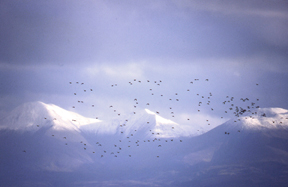Wind-aided birds on their way north
April 14, 2012
907-474-7468
4/13/2012
After flying northward from Chile, a whimbrel landed in late March in an alfalfa field near Mexicali, Mexico. The handsome shorebird with a long curved beak left its wintering ground in South America one week earlier and flew more than 5,000 miles. Nonstop.
In one of the great migrations happening all over the world right now, the bird is heading to northern Alaska. Once there, it should touch down on tundra along the Colville River, about 25 miles inland from the Beaufort Sea coast.
Bob Gill knows the location of the bird because he got a text message of its whereabouts on the same day he gave a presentation in Fairbanks. The bird biologist with the U.S. Geological Survey’s Science Center in Anchorage reported on how changing conditions in the weather factory known as the atmosphere might affect whimbrels, godwits, curlews and other birds that make amazing, wind-aided journeys twice each year.
For years Gill has traveled in autumn to estuaries along the Alaska Peninsula. While there, he has squinted into the wind and spitting rain of magnificent storms. Early in his studies of bar tailed godwits, Gill would be surprised to crawl from his tent and find his birds had disappeared.

Now he knows the birds use the big storms to slingshot themselves out of Alaska. From here, the birds fly to New Zealand. They spend a week in the air without stopping, eating or drinking, losing half their body weight on the way. They might even snooze on the fly.
Researchers have looked at weather patterns for the godwits’ departure from southwest Alaska and have found that the birds often begin their migration when a big low-pressure system is spinning counterclockwise into the Gulf of Alaska. The birds sit tight when the low sits in the Bering Sea, producing headwinds on a journey to the North Pacific.
The birds’ ability to choose the right winds seems further supported by the work of the USGS’s Dave Douglas, who looked at the flight paths of 37 godwits the team had fitted with transmitters during the past six years. He found that a vast majority of the birds had tailwinds for the majority of their great migration route encircling the Pacific from Alaska to New Zealand in fall, from New Zealand to the Yellow Sea in early spring, and from the Yellow Sea back to Alaska later in May.
In another study, a researcher with the Max Plank Institute of Ornithology used weather data and a computer model to predict the fastest possible routes bristle-thighed curlews should take when migrating from Alaska’s Seward Peninsula to the South Pacific.
“All but two curlews followed the optimum route to their destination,” Douglas said.
How do birds manage to take off at the front end of weather systems and somehow ride the best conditions for thousands of miles? Scientists are not sure, Gill said, but the birds seem to be able to integrate changing local weather, such as wind direction and atmospheric pressure, into an excellent flight plan. At Gill’s presentation, National Weather Service meteorologist Gary Hufford said he wished he could recruit godwits to forecast the weather.
Though the birds have an excellent track record, Douglas showed a few examples of godwits that faced severe headwinds on their journeys. One got caught in a fast-developing high-pressure system on its journey back from the Yellow Sea to Alaska. The bird got almost within sight of St. Paul Island when it gave up, turned around and flew back to Kamchatka. There, it rested a week before trying again and making it to Alaska (though the added time seemed to have prevented the female from raising a brood).
Another godwit ran into a bit of bad luck in its transit from Alaska to New Zealand one fall. An “explosive cyclone” of high winds entrapped the bird, reducing its speed by half. The bird landed short of New Zealand, in New Caledonia, and was dead within a week.
Gill and Douglas are now teaming with meteorologists and other scientists to see how large-scale changes in climate, such as more rogue storms, might affect these flyers. Gill wonders if the birds can change as fast as the climate seems to be, but he’s impressed by their resilience.
“It’s intriguing to see these guys out there charging into those storms that we’re so afraid of,” Gill said. “These birds have been doing this for tens of thousands of years . . . I don’t think they’re truly as fragile as our anthropomorphic thinking might suggest.”
This column is provided as a public service by the Geophysical Institute at the University of Alaska Fairbanks, in cooperation with the UAF research community.


